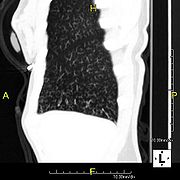
Tree-in-bud sign
Encyclopedia

Radiology
Radiology is a medical specialty that employs the use of imaging to both diagnose and treat disease visualized within the human body. Radiologists use an array of imaging technologies to diagnose or treat diseases...
, the tree-in-bud sign is a finding on computed tomography
Computed tomography
X-ray computed tomography or Computer tomography , is a medical imaging method employing tomography created by computer processing...
(CT) scans that indicates some degree of airway
Airway
The pulmonary airway comprises those parts of the respiratory system through which air flows, conceptually beginning at the nose and mouth, and terminating in the alveoli...
plugging.
It is associated with infection
Infection
An infection is the colonization of a host organism by parasite species. Infecting parasites seek to use the host's resources to reproduce, often resulting in disease...
that has spread endobronchially and is classically associated with tuberculosis
Tuberculosis
Tuberculosis, MTB, or TB is a common, and in many cases lethal, infectious disease caused by various strains of mycobacteria, usually Mycobacterium tuberculosis. Tuberculosis usually attacks the lungs but can also affect other parts of the body...
and bronchopneumonia
Bronchopneumonia
Bronchopneumonia or bronchial pneumonia or "Bronchogenic pneumonia" is the acute inflammation of the walls of the bronchioles...
. It is often seen in bronchiectasis
Bronchiectasis
Bronchiectasis is a disease state defined by localized, irreversible dilation of part of the bronchial tree caused by destruction of the muscle and elastic tissue. It is classified as an obstructive lung disease, along with emphysema, bronchitis, asthma, and cystic fibrosis...
, which may occur secondary to mucus plugging in cystic fibrosis
Cystic fibrosis
Cystic fibrosis is a recessive genetic disease affecting most critically the lungs, and also the pancreas, liver, and intestine...
.
The tree-in-bud pattern represents bronchiolar luminal impaction with mucus, pus, or fluid, which demarcates the normally invisible branching course of the peripheral airways. In addition, dilated and thickened walls of the peripheral airways and peribronchiolar inflammation can contribute to the visibility of affected bronchioles. In histopathologic studies, the tree-in-bud appearance correlates well with the presence of plugging of the small airways with mucus, pus, or fluid; dilated bronchioles; bronchiolar wall thickening; and peribronchiolar inflammation

